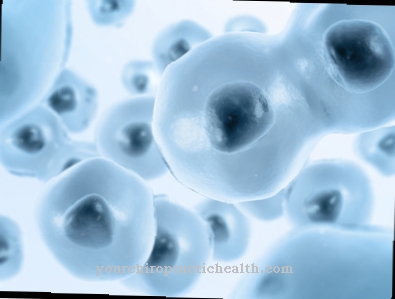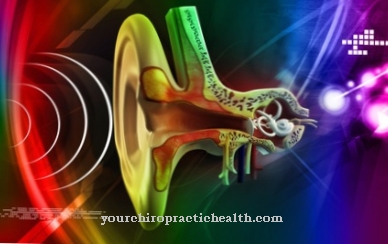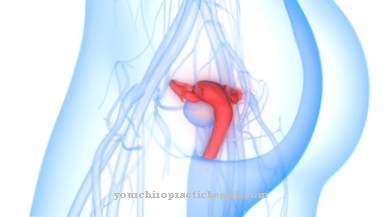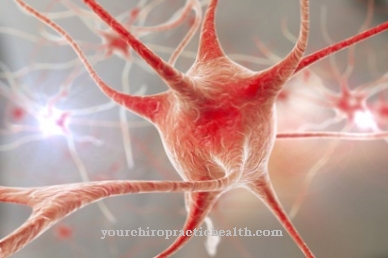The Insulin Synthesis is induced in the organism when eating. Insulin is a hormone that induces the cells to take up glucose through the cell membrane. A decrease in insulin synthesis leads to an increase in the level of sugar in the blood.
What is Insulin Synthesis?

Insulin is the only hormone in the body that can lower the blood sugar level in the blood. Insulin synthesis is always necessary when carbohydrates are taken in with food. Insulin synthesis takes place in the Langerhans cells of the pancreas.
If too little insulin is produced, the blood sugar level rises because the glucose is no longer transported into the cells. Excessive insulin synthesis leads to low blood sugar (hypoglycaemia) with hunger pangs, restlessness and threatened nerve damage.
Insulin synthesis occurs at intervals and is always stimulated by food intake. If the carbohydrate intake is reduced, for example due to starvation, the blood sugar level drops. More glucagon is formed than the antagonist of insulin. Glucagon increases blood sugar levels through gluconeogenesis. As a result, the secretion of insulin decreases and its synthesis is restricted.
Overall, the insulin synthesis is part of a complicated regulatory mechanism to keep the blood sugar level constant.
Function & task
Providing insulin ensures that the body is supplied with energy and building blocks. Insulin has an anabolic effect on metabolism. Insulin production includes both insulin synthesis and insulin secretion.
Insulin is produced and stored in the islet cells of Langerhans in the pancreas. When the blood sugar level rises, glucose enters the beta cells of the islets of Langerhans via vesicles, which immediately release stored insulin. At the same time, the insulin synthesis is stimulated.
First, an inactive preproinsulin molecule with 110 amino acids is formed on the ribosomes. This preproinsulin consists of a signal sequence with 24 amino acids, the B chain with 30 amino acids, two additional amino acids and a C chain with 31 amino acids, another two amino acids and an A chain with 21 amino acids.
Once formed, the stretched molecule is folded through the formation of three disulfide bridges. Two disulfide bridges connect the A and B chains. The third disulfide group is within the A chain. The preproinsulin is initially located in the endoplasmic reticulum. From there it is transported through the membrane to get into the Golgi apparatus.
During the passage of the ER through the membrane, the signal peptide is split off, which then remains in the cisterns of the endoplasmic reticulum. After the signal sequence has been split off, proinsulin is formed, which has 84 amino acids. After it has been incorporated into the Golgi apparatus, it is stored there.
If there is a stimulus to release, the C chain is split off by the action of specific peptidases. Now insulin is formed, which consists of an A-chain and a B-chain. The two chains are only linked by two disulphide bridges. A third disulfide group is located within the A chain to stabilize the molecule.
The insulin is then stored in the vesicles of the Golgi apparatus in the form of zinc-insulin complexes. Hexamers are formed, which stabilize the structure of the insulin. The release of insulin is triggered by certain stimuli. The increase in blood sugar level is the main triggering stimulus. But the presence of various amino acids, fatty acids and hormones also have a stimulating effect on the release of insulin.
The triggering hormones include secretin, gastrin, GLP-1 and GIP. These hormones are always formed when you eat. After ingestion, insulin secretion occurs in two phases. In the first phase the stored insulin is released, while in the second phase it is re-synthesized. The second phase is not completed until the hyperglycemia has ended.
Illnesses & ailments
When insulin synthesis is disturbed, the blood sugar level increases. A chronic insulin deficiency is called diabetes mellitus. There are two types of diabetes, type I diabetes and type II diabetes.
Type I diabetes is an absolute lack of insulin. If the islet cells of Langerhans are absent or due to a disease, too little or no insulin is produced. Possible causes are severe inflammation of the pancreas or autoimmune diseases. The blood sugar level is extremely high in this form of diabetes. Without insulin substitution, the disease leads to death.
Type II diabetes is caused by a relative lack of insulin. Sufficient insulin is produced in the process, and insulin secretion is even increased. However, the insulin resistance is increased because the effectiveness of the insulin is reduced due to the lack of receptors. The pancreas has to produce more insulin to achieve the same effects. This increased insulin synthesis leads to the exhaustion of the islets of Langerhans in the long term. Type II diabetes develops.
In the context of hormonal regulation disorders, an increased blood sugar level can also occur. With increased cortisol activity, more glucose is produced from amino acids through gluconeogenesis. As a result, the insulin synthesis is permanently stimulated in order to lower the blood sugar level again. The excess glucose is transported into the fat cells, where increased fat formation takes place. A trunk obesity develops. The disease is known as Cushing's syndrome.
A permanently high level of insulin synthesis can also be triggered by a tumor in the islet cells of Langerhans. It is a hyperinsulinism, which is often triggered by an insulinoma and leads to repeated hypoglycaemia.

























.jpg)

.jpg)
